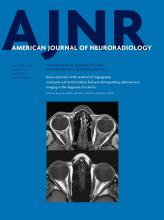Index by author
Hoffman, B.
- Adult BrainYou have accessCT Perfusion in Acute Lacunar Stroke: Detection Capabilities Based on Infarct LocationJ.C. Benson, S. Payabvash, S. Mortazavi, L. Zhang, P. Salazar, B. Hoffman, M. Oswood and A.M. McKinneyAmerican Journal of Neuroradiology December 2016, 37 (12) 2239-2244; DOI: https://doi.org/10.3174/ajnr.A4904
Hoffmann, C.
- Pediatric NeuroimagingYou have accessPrenatal Evaluation, Imaging Features, and Neurodevelopmental Outcome of Prenatally Diagnosed Periventricular PseudocystsS. Cooper, O. Bar-Yosef, M. Berkenstadt, C. Hoffmann, R. Achiron and E. KatorzaAmerican Journal of Neuroradiology December 2016, 37 (12) 2382-2388; DOI: https://doi.org/10.3174/ajnr.A4916
Hojjat, S.P.
- EDITOR'S CHOICEAdult BrainOpen AccessComparison of Quantitative Cerebral Blood Flow Measurements Performed by Bookend Dynamic Susceptibility Contrast and Arterial Spin-Labeling MRI in Relapsing-Remitting Multiple SclerosisR.M. D'Ortenzio, S.P. Hojjat, R. Vitorino, C.G. Cantrell, L. Lee, A. Feinstein, P. O'Connor, T.J. Carroll and R.I. AvivAmerican Journal of Neuroradiology December 2016, 37 (12) 2265-2272; DOI: https://doi.org/10.3174/ajnr.A4939
Both dynamic susceptibility contrast perfusion with bookend T1-calibration and pseudocontinuous arterial spin-labeling have been used recently for CBF quantification in relapsing-remitting MS. The authors compared pseudocontinuous arterial spin-labeling CBF with the bookend technique in a prospective cohort of 19 healthy controls, 19 subjects with relapsing-remitting MS without cognitive impairment, and 20 subjects with relapsing-remitting MS with cognitive impairment. Voxelwise paired t tests revealed no significant CBF differences between techniques after normalization of global meanintensities. They conclude that there is agreement between pseudocontinuous arterial spin-labeling and bookend technique CBF measurements in healthy controls and patients with relapsing-remitting MS.
Holodny, A.I.
- You have access“Am I about to Lose my Job?!”: A Comment on “Computer-Extracted Texture Features to Distinguish Cerebral Radiation Necrosis from Recurrent Brain Tumors on Multiparametric MRI: A Feasibility Study”A.I. HolodnyAmerican Journal of Neuroradiology December 2016, 37 (12) 2237-2238; DOI: https://doi.org/10.3174/ajnr.A5002
Hurrell, S.L.
- EDITOR'S CHOICEAdult BrainOpen AccessProgressing Bevacizumab-Induced Diffusion Restriction Is Associated with Coagulative Necrosis Surrounded by Viable Tumor and Decreased Overall Survival in Patients with Recurrent GlioblastomaH.S. Nguyen, N. Milbach, S.L. Hurrell, E. Cochran, J. Connelly, J.A. Bovi, C.J. Schultz, W.M. Mueller, S.D. Rand, K.M. Schmainda and P.S. LaVioletteAmerican Journal of Neuroradiology December 2016, 37 (12) 2201-2208; DOI: https://doi.org/10.3174/ajnr.A4898
The authors explored regions of diffusion restriction following bevacizumab therapy in patients with glioblastoma by 1) analyzing tissue samples from patients at postmortem to pathologically confirm tumor cellularity or coagulative necrosis and 2) assessing the patient populationto determine the effect that these lesions have on overall survival. The postmortem examinations were performed on 6 patients with recurrent glioblastoma on bevacizumab withprogressively growing regions of diffusion restriction. ADC values were extracted from regions of both hypercellular tumor and necrosis. They conclude that progressive diffusion-restricted lesions were pathologically confirmed to be coagulative necrosis surrounded by viable tumor and associated with decreased overall survival.
Hwang, S.N.
- PediatricsOpen AccessRelative ADC and Location Differ between Posterior Fossa Pilocytic Astrocytomas with and without Gangliocytic DifferentiationJ.H. Harreld, S.N. Hwang, I. Qaddoumi, R.G. Tatevossian, X. Li, J. Dalton, K. Haupfear, Y. Li and D.W. EllisonAmerican Journal of Neuroradiology December 2016, 37 (12) 2370-2375; DOI: https://doi.org/10.3174/ajnr.A4892








